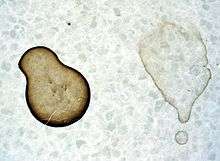Stain

A stain is a discoloration that can be clearly distinguished from the surface, material, or medium it is found upon. They are caused by the chemical or physical interaction of two dissimilar materials. Staining is used for biochemical research, metal staining, and art (e.g., wood staining, stained glass).
Types of stains
There can be intentional stains (such as wood stains or paint),[1] indicative stains (such as food coloring or adding a substance to make bacteria visible under a microscope),[2] natural stains (such as rust on iron or a patina on bronze),[3] and accidental stains such as ketchup on a shirt.
Different types of material can be stained by different substances, and stain resistance is an important characteristic in modern textile engineering.
Formation
The primary method of stain formation is surface stains, where the staining substance is spilled out onto the surface or material and is trapped in the fibers, pores, indentations, or other capillary structures on the surface.[1] The material that is trapped coats the underlying material, and the stain reflects back light according to its own color. Applying paint, spilled food, and wood stains are of this nature.[4]
A secondary method of stain involves a chemical or molecular reaction between the material and the staining material. Many types of natural stains fall into this category.
Finally, there can also be molecular attraction between the material and the staining material, involving being held in a covalent bond and showing the color of the bound substance.[5]
Properties
In many cases, stains are affected by heat and may become reactive enough to bond with the underlying material. Extreme heat, such as from ironing or dry cleaning, can cause a chemical reaction on an otherwise removable stain, turning it into a chemical compound that is impossible to remove.[5]
Removal
Various laundry techniques exist to attempt to remove or minimize existing stains, and stain removers are an important type of chemical in laundry detergents. Some stand-alone stain removers also exist.If the wrong technique is used to remove the stain / stain mark on the clothing it could actually create permanent damaged to the clothing.[6]
See also
Further reading
- Stain & Spot Removal Handbook: Consumer guide. by the editors of Consumer Guide.. Skokie, Ill:Beekman House, 1981. 9780517316832
- Zia, Stephanie. Stain Removal. London: Hamlyn, 2005.Distributed in the U.S. and Canada by Sterling Pub. Co., 2005. 9780600611240
- Soto, Anne MarieStain Rescue!: The A-Z Guide to Removing Smudges, Spots & Other Spills By good Housekeeping Institute (New York, N.Y.). Published by Sterling Publishing Company, 2007 ISBN
- Mendelson, Cheryl Laundry: The Home Comforts Book of Caring for Clothes and Linens Simon & Schuster, 2005 ISBN 978-0-7432-7145-5
References
- 1 2 Bob Flexner (1999). "Understanding Wood Finishing: How to Select and Apply the Right Finish". Reader's Digest: 121. ISBN 978-0-7621-0191-7.
- ↑ George Clark, James W. Bartholomew (1981). Staining Procedures Used by the Biological Stain Commission: Published for the Biological Stain Commission. Williams & Wilkins. pp. 32–33. ISBN 978-0-683-01707-6.
- ↑ L. William Zahner (1997). Architectural Metals: A Guide to Selection, Specification, and Performance. Wiley. p. 101. ISBN 978-0-471-04506-9.
- ↑ NACE International (1987). Materials Performance. 26. National Association of Corrosion Engineers. p. 33.
- 1 2 Max Alth, Simon Alth (1977). The Stain Removal Handbook. Hawthorn Books. p. 22. ISBN 978-0-8015-7071-1.
- ↑ [1]
External links
-
 The dictionary definition of stain at Wiktionary
The dictionary definition of stain at Wiktionary -
 Media related to stains at Wikimedia Commons
Media related to stains at Wikimedia Commons - Solutions for Clothing and Laundry Stain Removal[1]